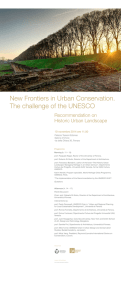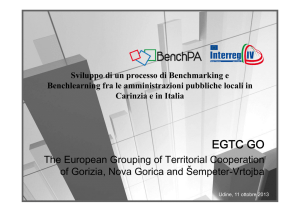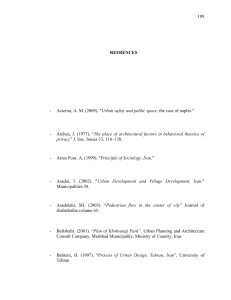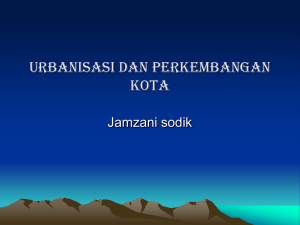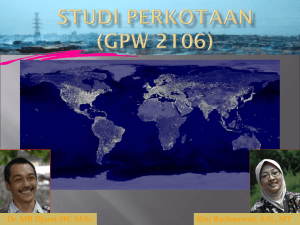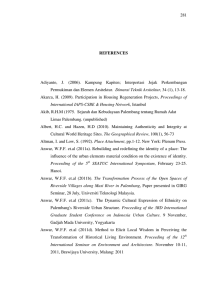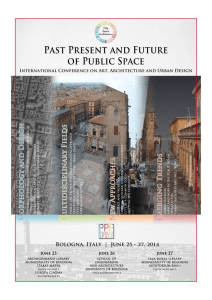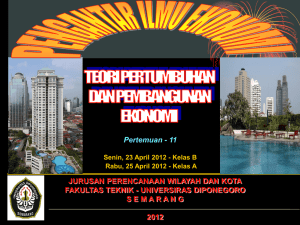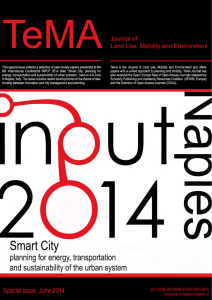Fringe-belt theory and polarities
advertisement
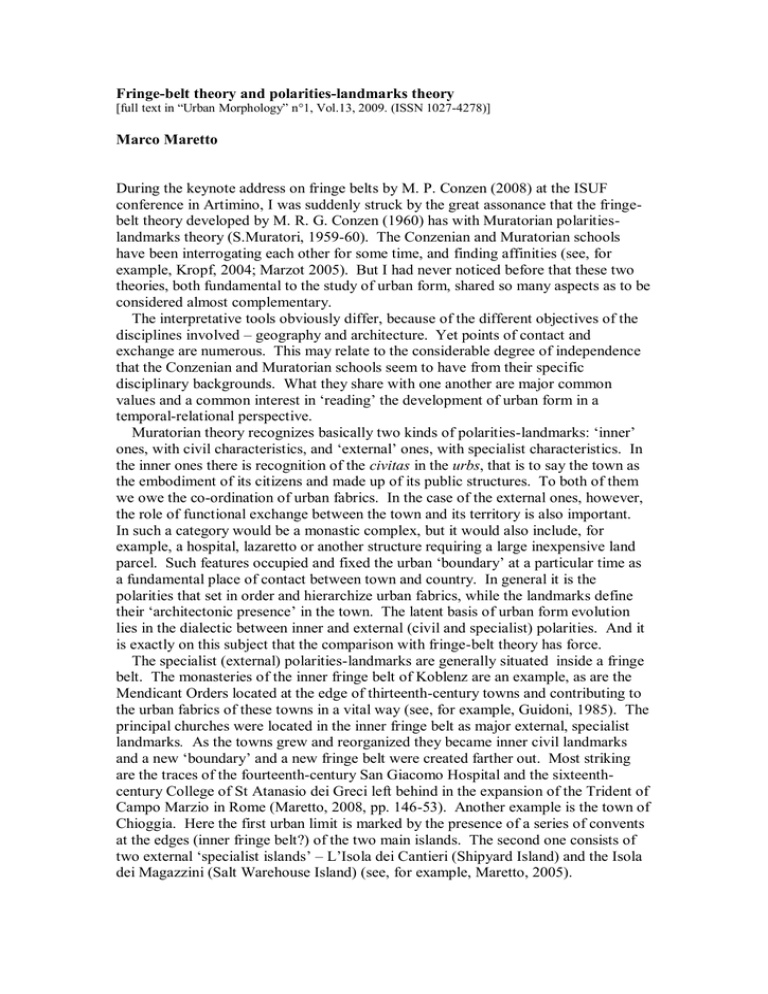
Fringe-belt theory and polarities-landmarks theory [full text in “Urban Morphology” n°1, Vol.13, 2009. (ISSN 1027-4278)] Marco Maretto During the keynote address on fringe belts by M. P. Conzen (2008) at the ISUF conference in Artimino, I was suddenly struck by the great assonance that the fringebelt theory developed by M. R. G. Conzen (1960) has with Muratorian polaritieslandmarks theory (S.Muratori, 1959-60). The Conzenian and Muratorian schools have been interrogating each other for some time, and finding affinities (see, for example, Kropf, 2004; Marzot 2005). But I had never noticed before that these two theories, both fundamental to the study of urban form, shared so many aspects as to be considered almost complementary. The interpretative tools obviously differ, because of the different objectives of the disciplines involved – geography and architecture. Yet points of contact and exchange are numerous. This may relate to the considerable degree of independence that the Conzenian and Muratorian schools seem to have from their specific disciplinary backgrounds. What they share with one another are major common values and a common interest in ‘reading’ the development of urban form in a temporal-relational perspective. Muratorian theory recognizes basically two kinds of polarities-landmarks: ‘inner’ ones, with civil characteristics, and ‘external’ ones, with specialist characteristics. In the inner ones there is recognition of the civitas in the urbs, that is to say the town as the embodiment of its citizens and made up of its public structures. To both of them we owe the co-ordination of urban fabrics. In the case of the external ones, however, the role of functional exchange between the town and its territory is also important. In such a category would be a monastic complex, but it would also include, for example, a hospital, lazaretto or another structure requiring a large inexpensive land parcel. Such features occupied and fixed the urban ‘boundary’ at a particular time as a fundamental place of contact between town and country. In general it is the polarities that set in order and hierarchize urban fabrics, while the landmarks define their ‘architectonic presence’ in the town. The latent basis of urban form evolution lies in the dialectic between inner and external (civil and specialist) polarities. And it is exactly on this subject that the comparison with fringe-belt theory has force. The specialist (external) polarities-landmarks are generally situated inside a fringe belt. The monasteries of the inner fringe belt of Koblenz are an example, as are the Mendicant Orders located at the edge of thirteenth-century towns and contributing to the urban fabrics of these towns in a vital way (see, for example, Guidoni, 1985). The principal churches were located in the inner fringe belt as major external, specialist landmarks. As the towns grew and reorganized they became inner civil landmarks and a new ‘boundary’ and a new fringe belt were created farther out. Most striking are the traces of the fourteenth-century San Giacomo Hospital and the sixteenthcentury College of St Atanasio dei Greci left behind in the expansion of the Trident of Campo Marzio in Rome (Maretto, 2008, pp. 146-53). Another example is the town of Chioggia. Here the first urban limit is marked by the presence of a series of convents at the edges (inner fringe belt?) of the two main islands. The second one consists of two external ‘specialist islands’ – L’Isola dei Cantieri (Shipyard Island) and the Isola dei Magazzini (Salt Warehouse Island) (see, for example, Maretto, 2005). Generally speaking, if we confine our analysis to pre-twentieth-century cities, the limit marked by the external polarities-landmarks represents a kind of ‘architectural translation’ of the Conzenian fringe belt. These are preliminary thoughts, but there are attractive possibilities for extending them further. References Conzen, M. P. (2008) ‘How growing cities internalize their old urban fringes: a cross cultural comparison’, unpublished paper presented to the Fifteenth International Seminar on Urban Form, Artimino, Italy, November. Conzen, M. R. G. (1960) Alnwick, Northumberland: a study in town-plan analysis Institute of British Geographers Publication 27 (George Philip, London). Guidoni, E. (1985) ‘Città e ordini Mendicanti. Il ruolo dei conventi nalla crescita e nella progettazione urbana dei secoli XIII e XIV’, Quaderni Medievali 4, 69-106. Kropf, K. (2004) ‘M. R. G. Conzen, Gianfranco Caniggia, Oscar Wilde and Aesop: or, why urban morphology may be right but not popular’, Urban Morphology 8, 26-8. Maretto, M. (2005) ‘Urban morphology as a basis for urban design: the project for the Isola dei Cantieri in Chioggia’, Urban Morphology 9, 29-44. Maretto, M. (2008) Il Paesaggio delle differenze (ETS, Pisa) 89-133. Marzot, N. (2005) ‘Typological analysis and hermeneutics in the Conzenian and Caniggian schools: overlaps and differences’, Urban Morphology 9, 48-50. Muratori, S. (1959-1960) Studi per una operante storia urbana di Venezia (Istituto Poligrafico dello Stato, Roma). Muratori, S., Bollati, R., Bollati, S., Marinucci, G. (1963) Studi per una operante storia urbana di Roma (C.S.S.U., Roma).
